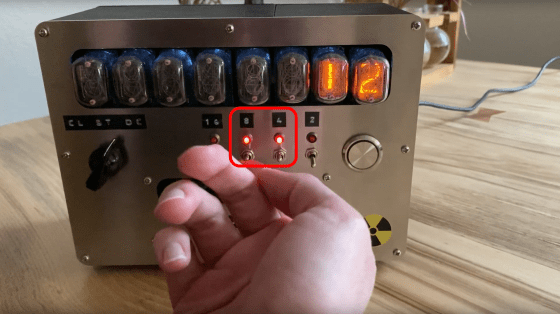A fierce person who generates quantum random numbers using radioactive materials appears

Random numbers used in data encryption and programming include
GitHub-nategri / chernobyl_dice: A quantum random number generator with a Cold War aesthetic.
https://github.com/nategri/chernobyl_dice
'Chernobyl Dice' is a quantum random number generator that uses the fission reaction of weakly radioactive materials as an entropy source. Chernobyl Dice is composed of Arduino Nano as a substrate, Geiger counter of radiation meter, 6 uranium glasses , and Nixie tube , and operates with the following program.
1. Depending on whether the Geiger counter has responded, 0 or 1 is recorded in the ring buffer every millisecond.
2. Using von Neumann's stability analysis , remove the bias of the generated initial random numbers.
3. The bias is further removed by XORing the bits generated in the second step with mod2, which is the time in microseconds since the device was powered on, divided by 4.
The following movie shows how Chernobyl Dice is operating.
Turn the dial to 'CL' to enter the clock mode that displays the current time. There are three modes: a streaming mode in which random numbers are repeatedly generated and output from USB, and a dice mode in which one random number is displayed when the button is pressed once.

If you turn the dial to 'DC', you will be in a dice mode where one random number is displayed each time you press the button.

The sum of the numbers with the knobs corresponds to the range of random numbers generated. Turning up knobs 4 and 8 will generate a random number between 0 and 12.

Press the button ...

A binary number is displayed on the Nixie tube and random number generation begins.

This time '2' was generated.

If you set the rotation to 'ST', you can use the streaming mode to repeatedly generate random numbers and output from USB.

According to Python's statistical tests, all tests were cleared. It shows that Chernobyl Dice is a very unbiased random number generator.

A parts list for creating Chernobyl Dice is also available.

It looks like this is actually assembling Chernobyl Dice. Install the spacer on the

Assemble the logic board.

Connect the Nixie tube to the logic board ...

Assemble to the enclosure.

Assemble the Geiger counter into the enclosure.

Then attach the uranium glass marble.

After connecting the control panel board, attach the buttons and you're done.

In addition, during the operation of Chernobyl Dice, the uranium glass marble glows green by ultraviolet rays, but this has nothing to do with radioactive material, it seems to be shining because it is cool.
Related Posts:







